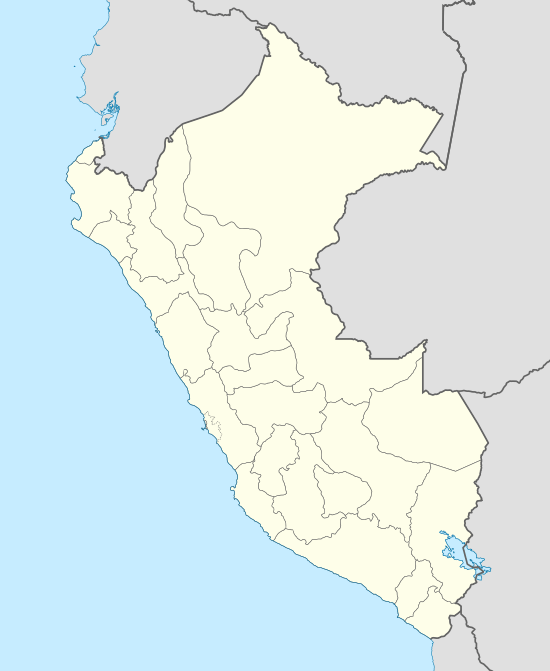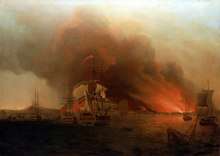Paita
Paita is a city in northwestern Peru. It is the capital of the Paita Province which is in the Piura Region. It is a leading seaport in that region. It is located 1,089 km northwest of the country's capital Lima and 57 km northwest of the regional capital of Piura. Starting in 2014, it has entertained ideas for the separation Paita from Piura Region, proclaiming itself "Miguel Grau region".
- For the town in New Caledonia, see Païta.
Paita | |
|---|---|
City | |
.jpg)  _is_anchored_in_the_fishing_town_of_Paita%2C_Peru.jpg) | |
 Flag  Seal | |
 Paita Location of the city of Paita in Peru | |
| Coordinates: 5°5′28″S 81°06′23″W | |
| Country | |
| Region | Piura |
| Province | Paita |
| District | Paita |
| Established | 1782 |
| Government | |
| • Mayor | Teodoro Edilberto Alvarado Alayo |
| Area | |
| • Total | 1,768.65 km2 (682.88 sq mi) |
| Elevation | 350 m (1,150 ft) |
| Population (2016) | |
| • Total | 179,346 |
| • Estimate (2015)[1] | 168 900 |
| Demonym(s) | Paiteño (a) |
| Time zone | UTC-5 (PET) |
| • Summer (DST) | UTC-5 (PET) |
| Website | www.munipaita.gob.pe |
Location
The seaport city Paita is located at 05°05′28″S 81°06′23″W on a small peninsula south of the mouth of the Río Chira on an area of 1,785 km².
Paita faces on the Bay of Paita, and is sheltered from southerly winds by a headland called Punta Paita and by a large hill called Silla de Paita.
90 km to the south east is the capital of the Piura Region, Piura, and 160 km to the south is located Chiclayo, commercial centre of the Lambayeque region.
Population
The population of the seaport Paita was 3,800 in 1906, 20 000 in 1993, 122 127 in 2007 and 168 900 in 2015
History
Prehistoric Era
Paleontologist Edgar Herning (1960) collected remains in 1978 considering this a highly evolved cultural group, reporting that 9000 years ago there were primitive villages of the coast of Paita like Colan, Tayta and Amotape.
Colonial Period

From 1578 to 1588, Paita was the Spanish capital of the northwestern Peruvian coast, before the permanent attacks of English pirates and corsairs made it necessary to relocate the capital at Piura.
The port of Paita is best known to many Peruvians as the former home of Manuela Sáenz, Simón Bolívar's lover.
Whaling port
Paita was a significant port of call for whaling ships in the first half of the 19th century. The whaling grounds west of Peru were popular with British and American whaling ships and they often called at Paita for supplies and repairs. Local men were sometimes recruited to serve as crewmen on these vessels. The first vessel known to have called was the British whaler Emilia in 1792.[2] Sixty-four American whalers visited in 1833 alone.[3] So many American vessels called that in 1833 the United States government decided to establish a consulate at Paita. A hospital was established for sick or injured American seaman in the 1840s.[4] The large protected Bay of Paita provided a safe anchorage for visiting vessels and the irrigated farms of the nearby Chira valley produced a wide range of agricultural produce for the whalers. The money they injected into the local economy provided substantial economic benefit to the town and hinterland and this continued till American whaling visits began to taper off in the 1860s.
Industry
In 1875, a railway line of 97 km length was completed from Piura to Paita, but it was destroyed in the war with Chile from 1879 to 1883 and reconstructed in 1884. A street railway opened on 30 August 1891 and ran until the late 1920s.
Today the port of Paita is Peru's fifth largest port and an important container port. It is located in a geopolitically important position on the Pacific coast.
Paita has one of the best natural harbours of the Peruvian coast and runs regular mail steamers between Valparaíso and Panama.
Celebrations
On 24 September the Fiesta de Nuestra Señora de las Mercedes is celebrated, lasting a week and including pilgrimages in honor of the catholic iconic image.
Twin towns and sister cities
Cultural references
The Golden Ocean by Patrick O'Brian, first published in 1954 then again in 1996, mentions the successful attack of Anson's squadron at Paita in his voyage around the world, taking a prize of merchant's gold, silver and trade goods, valued at 30,000 British pounds.
In the 1947 film Dark Passage, Humphrey Bogart's character, falsely blamed for three murders, flees to Paita, with hopes of linking up with love interest. He tells her of "a little cafe right on the bay". Parts of the telephone conversation are used in the 1982 film Dead Men Don't Wear Plaid.
References
- Perú: Población estimada al 30 de junio y tasa de crecimiento de las ciudades capitales, por departamento, 2011 y 2015. Perú: Estimaciones y proyecciones de población total por sexo de las principales ciudades, 2012-2015 (Report). Instituto Nacional de Estadística e Informática. March 2012. Retrieved 4 June 2015.
- William L. Lofstrom (1996), Paita; outpost of empire, Mystic, Connecticut, Mystic Seaport Museum, p.18. ISBN 0913372749
- Sydney Morning Herald, 9 January 1834, p.2
- Lofstrom, p.57